Update Nov. 24, 2014: I can’t explain what is going on, but it seems that at least 3 new people have left comments on this post expressing that they noticed this phenomena. They, being females who have gone through, or are going through pregnancy, have noticed changes in their height.


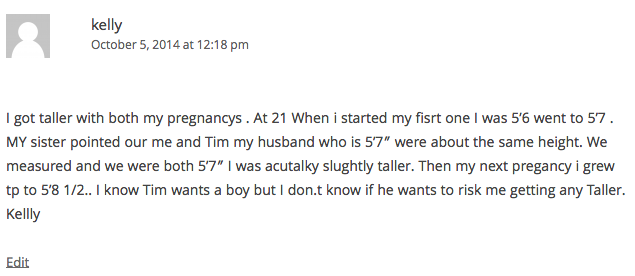
So more and more females are coming out and telling us their unique individual stories
First, obviously this phenomena is NOT a common thing. It probably happens to just 0.01% of all women who go through pregnancy, and that is a guess on the high side. However, just the fact that more than a dozen females have claimed this phenomena makes me really wonder what is going on.
I have had a recent new idea, which is that the irregular bones in the feet might have grown larger appositionally pushing the overall female skeleton higher up. However, that is a real stretch.
The connection and theory that all this increase in height is due to the chemical relaxin however is still the most viable theory.
Refer to one of the most explosive posts I have ever written on this website – “The Chemical That Would Make Adults Grow Taller Has Been Found”
However, the recent claim made by my own girlfriend that she grew 1 full cm herself made me wonder whether this phenomena may be due to more than 1 main human physiological process.
One thing that is very obvious however is that about 98% of all the claims ever made about growing taller in adulthood (which I will assume to be around the age point of 21-22_ has been by females. Is there something within the human female bone physiology which makes them more likely to grow slightly taller?
Update Feb 14th, 2014: It seems that just in the span of 24 hours, two women have come forth and sent messages to the website expressing the fact that they either have open epiphyseal growth plates at the age of almost 30 or even later.
Case Study #1: This women went to get X-Rays for her ankle bone area/ distal tibia after a fall and she noticed that her bones had scars across the ankle bones. She messaged me and commented that she apparently found out that she still had growth plates. The post that she commented on is “A Theory That Epiphyseal Growth Plates Never Fuse For Certain People”

Case Study #2: This 2nd women commented that apparently she has grown by about 4 inches in the last of her 2 pregnancies, out of a total of 5 pregnancies. This case is extremely unusual because most cases we have found have the mother increase in height during the first and/or the 2nd pregnancies. The fact that this women is in her late 30s is absolutely amazing. I would suspect that her bone maturity is very unique, but possible due to cases I’ve found before.
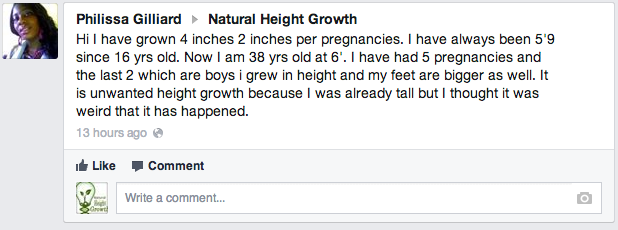
There is now too much evidence coming through in the form of anecdotal stories, forum postings, cases and instances where adult females who went through pregnancy have noticed that they increased in height. Me and the follow researchers will focus much more on this pressing issue in the future. Currently, I have documented at least 11 cases of women who went through the phenomena. At least one of these women have found this website and contacted me personally through the website email and we have exchanged messages. The latest case has a women increase her height by 3 inches from 5′ 2″ – 5′ 5″.
Update 8/13/2013: It is noted that another commenter who goes by the name of guiselka wrote on the post “More Evidence That Pregnancy Can Increase Height, WOW!” recently wrote the following comment…
I used to be 5’2.5″ before pregnancy. I was just measured at my doctor visit and I am 5’5″. I am amazed! I also have many back problems now though. I’ve always had some issues but after pregnancy they became unbearable. I have a total of 4 hernias and 2 bulging discs among other problems.
Update 7/28/2013: I became aware that there has been at least another case where a pregnant women noticed that she gained height from her pregnancy. The source of the case is from the news website Reddit on a thread entitled “Has anyone else noticed a increase in their height during pregnancy?”
- She noticed that her height increased from 5′ 2″ to 5′ 3″.
- Her feet increased from shoe size 5 to 6. 5.
- The length from her elbow to her wrist is supposed to be the same length as her feet. After checking, it was the same. This implies that her forearm might have lengthened as well.
- She was born at a length of 16 inches.
- Husband is 6′ 2″ and born with a length of 23 inches.
- The baby has been much lower in her pelvis
Some responses to the original post has been rather insightful and forced me to rethink some issues between the link of pregnancy and noticeable increases in height.
A visitor recently came on the website to leave a message which shows that there is more cases where an expectant mother might actually have so much stuff going through her body that she increases in height.
She (named Stacie) noticed that her husband/father of the baby is noticeably shorter from looking at pictures and she informed me that at 5′ 10″ already she does does not wish to be any taller.
I have written about this idea in multiple posts before where in certain rare cases of females, they notice from pregnancy they end up 1-2 inches (sometimes even 3 inches) taller.
Main Post: Analysis On The Possible Cause For Height Increase During Pregnancy
Some other results from Google on places where mothers and expectant mothers notice that they ended up taller than before.
- http://community.thebump.com/cs/ks/forums/thread/48132386.aspx
- http://www.justmommies.com/forums/f449-january-2008-playroom/951090-growing-taller-during-your-pregnancy.html
- http://wiki.answers.com/Q/Is_it_possible_for_a_woman_to_grow_taller_while_pregnant
- http://answers.yahoo.com/question/index?qid=20080330121816AAnAzC7
- http://www.cafemom.com/group/3019/forums/read/14437087/Height_growth_during_pregnancy
- http://www.babycenter.com/400_can-you-get-taller-during-pregnancy_11662458_831.bc
- http://www.mothering.com/community/t/986965/getting-taller-during-pregnancy
- http://www.thepregnancyforum.com/general-discussion/6401-possble-woman-grow-taller-after-having-baby.html
These questions asked on the various internet forums, blogs, and websites on the internet seems to validate what Stacie is saying. She is noticing that her partner/husband/father of the baby is looking rather shorter than average lately. The message was short and she wrote at the end that she was going to go to the doctor, whether normal family physician, gynecologist, or endocrinologist, about her noticing that she might be taller than before.
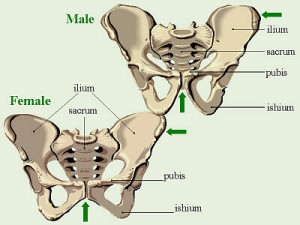 The conclusion that was reached by Tyler was that the cause was from this muscle relaxing protein called Relaxin, and his claim has a little bit of validity. We both found a study in PubMed which showed that the hip wide and hip size of heifers (young female cows before giving birth) seemed to have have gotten bigger from before the first pregnancy and after it.
The conclusion that was reached by Tyler was that the cause was from this muscle relaxing protein called Relaxin, and his claim has a little bit of validity. We both found a study in PubMed which showed that the hip wide and hip size of heifers (young female cows before giving birth) seemed to have have gotten bigger from before the first pregnancy and after it.
Could it be that from pregnancy, the hip bone in some women are twisted or bend open in such a way to actually stretch out the pubis symphysis?
Could the Pubis Symphysis be pulled in a way during the pregnancy and during the labor when the women is actually giving birth to make the alignment between the hip joint socket to the overall skeletal structure straighter, thus allowing for increased height?
Possibly but the height increase should be a few millimeters at most due to how the femur is attached to the hip bone. 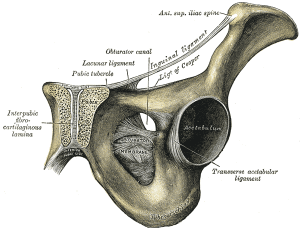
If we note that the epiphysis region of the proximal end of the femur is not attached to the hip bone in a vertical fashion, but horizontally, then it would not make sense to say that the stretching of such a small cartilage area in the middle of the hip should be able to cause the women to grow 1 inch, let alone 3 inches as reported by one person on an internet discussion board.
However we do have to note one thing that is well medically established. The documented phenomena of pregnant women who notice that their feet and hands and fingers becoming wider and even longer has been well observed.
This article from Discovery News indicates that the feet in pregnant women do get bigger and the increase in feet size never goes away.
“…Researchers measured the arch height and foot length of 49 women during their pregnancy and five months after they had given birth. On average, the women’s arch height decreased, and in turn, their foot length increased between 2 and 10 millimeters (about 0.1 to 0.4 inches) — during this period.
Overall, about 60 to 70 percent of the women had longer feet and shorter arches after childbirth, the researchers said. Eleven of the women reported changes in their shoe size, the researchers said”
So it seems to show that for the feet, they get longer by upwards of even 1 cm, which means that during and after pregnancy the women would could go up 2 shoe sizes. I guess that means it is time to go back shoe shopping to buy a whole new set of shoes.
The thing that is more interesting for us as height increase researchers is that the feet arch height is supposed to be decreased. The foot arch is the arch in the middle of the feet that gives the the feet its unique structure at the bottom. Most human feet at least in young kids have an arch. Older people from decades of walking and standing upright have flatter feet. So it seems that pregnancy causes women to have flatter feet.
So does having a shorter feet arch translate to a shorter overall height? It DOES.
The structure in the human feet that determines the overall height is composed of at least 4 small irregular tarsal bones. They are…
- The navicular bone
- The talus (aka ankle bone)
- The calcaneus
- Cuboid Bone
These four irregular bones are the 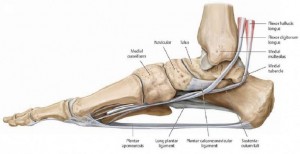 bones that are in the dorsal position of the feet. I chose to focus on these bones and NOT the tarsal bones in ventral side because these are the real bones that would be the main factors on determining height. If we look at the rest of the feet, we realize that how far up the human body is is slightly determined by how high the ankle is above the ground level. If the feet has a higher arch, it would be slightly taller, maybe by even 1 inch.
bones that are in the dorsal position of the feet. I chose to focus on these bones and NOT the tarsal bones in ventral side because these are the real bones that would be the main factors on determining height. If we look at the rest of the feet, we realize that how far up the human body is is slightly determined by how high the ankle is above the ground level. If the feet has a higher arch, it would be slightly taller, maybe by even 1 inch.
So this means that pregnancy should in fact then make women shorter then with slightly flatter, longer feet. The case where women get shorter from pregnancy seems to happen to the majority of women who go through pregnancy and notice any type of height variation.
The occasional case where women get taller should make no sense.
From the same article…
“…between 30 to 60 percent of women who had been pregnant at least once said their shoe size had changed.
The change in foot size may be due to the extra weight women carry around during pregnancy, which puts greater stress on the feet, and, thus, may flatten the arch, the researchers said. In addition, pregnant women produce hormones that increase the looseness of the joints and ligaments (tissue that connects bone to bone), possibly making the foot structure more malleable.
Most of the women involved in the new study who experienced changes in their foot length and arch height were first-time mothers. Women had given birth to two or three children did not experience such significant changes.”
So what is exactly going on then?
Tyler’s explanation currently is that from the type of hormone known as Relaxin released during pregnancy, the women develop looser ligaments and tendons so that when they stand up straight for say a height measurement during their annual physician checkup, the measured height goes up. That is plausible. However the logic would not explain why a new mother staying at home after giving birth, walking around with a regular posture, not stretching out completely for any height measurement, would notice that her husband/partner looks shorter than before. She is not stretching out her now looser ligaments for anything on purpose. This should mean that looser ligaments would do nothing for a women in average posture walking around in the privacy of their own home.
Humans in general are very good at noticing height changes between themselves and other people.
My explanation is that the same hormone that causes the tarsals to grow wider is also causing the cuboid, navicular, talus, and calcaneus to grow wider and bigger from appositional growth. The growth of the bones in width, since they are NOT long bones, but irregular bones, means that the feet should be getting taller if you measured the ankle protrusion relative to the ground level from before by upwards of even 1-2 cms. However this would not be enough to explain why any women should be able to gain 2-3 inches in extra height. That difference is too large.
Other than this explanation I would have no longer idea on how pregnancy makes some women taller.
Tyler’s Comments: If appositional increased as a result of pregnancy, it would have to be a huge increase to get a noticeable increase in height. I haven’t found any anecdotal accounts of people who would have potential for significant increases in appositional growth to have height increase like weight lifters, strong men, etc. Bone deposition can occur even on the longitudinal ends of long bones. Here’s a related study on non-periosteal bone growth and a study I mentioned here related to subchondral plate advancement. If bone apposition increased enough to increase longitudinal bone growth significantly enough to increase height then it would produce noticeable effects in terms of bone width. For example, did these females have to get bigger shoes because of the foot length or their foot width?
Here’s a recent study:
Anthropometric foot changes during pregnancy: a pilot study.
“Women’s feet change during pregnancy owing to hormonal and anatomical changes, thus having a strong influence on the decrease in their quality of life during pregnancy. This preliminary study aimed to value the anthropometric and positional changes that affect their feet. Methods: Ten pregnant women were measured during their gestational period to analyze the anthropometric changes in their feet from the 12th week of pregnancy. We examined the changes that occured in foot length, forefoot width, arch of the foot height, and the fixed position of the foot by using the Foot Posture Index, and we analyzed three intervals corresponding to pregnancy weeks 12, 24, and 34. Results: The most significant finding, with a reliability rate of 95%, is the decrease in internal arch height, which descends 0.65 mm (0.0394 inches) on average at the final stage of the pregnancy period. This change happened in 18 of the feet analyzed, tending toward pronation according to the measure provided by the Foot Posture Index, with a change of 3.78 points on this scale. Conclusions: The foot of the pregnant woman tends to flatten during gestational weeks 12 to 34, taking a more pronated posture, and the anthropometric changes in late pregnancy result in increases in foot length and forefoot width, changes that seem to be moderate.”
Will go back and look at this full study for additions but foot width does increase indicating that there may be more appositional growth but the change is said to be moderate so unlikely enough increase in appositional growth to be increasing height.
Also, the bones in the feet are different from typical long bones. For example the toe bone is not covered by articular cartilage.
Here’s my comments on relaxin and height in pregnancy and prolactin and height. Other potential hormones involved in the height increase could be HcG or HPL. According to this study(Suppression of streptococcal cell wall–induced arthritis by human chorionic gonadotropin), HcG can increase circulating TGF-Beta levels. However, the study Human placental lactogen directly inhibits rat cartilage growth processes in vivo and in vitro., found that HPG inhibits cartilage growth although it could be a different story for human cartilage.









